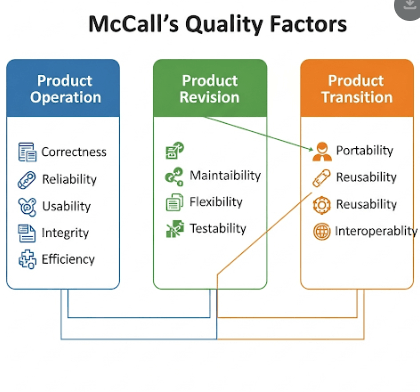- Metrics for Process and Products
- Software measurement
- Metrics for Software Quality
- Risk Management
- Reactive versus Proactive Risk Strategies
- Software Risks
- Risk Identification
- Risk Projection
- Risk Refinement
- RMMM
- RMMM Plan
- Quality Management
- Quality Concepts
- Software Reviews
- Formal Technical Reviews
- Statistical Software Quality Assurance
- Software Reliability
- The ISO 9000 Quality Standards
Introduction to Metrics for Software Quality
Metrics for software quality specifically focus on quantifying the various attributes that contribute to the overall excellence of a software product. These measures are vital for ensuring that the software not only meets its specified requirements but also satisfies implicit user needs and operates reliably. While quality factors are broadly understood, these metrics provide the concrete data needed to assess, track, and improve these attributes. By applying these metrics, development teams can gain objective insights into the product’s quality, identify areas for enhancement, and ultimately deliver more robust and user-satisfying software.
Key Quality Factors and Their Measurement
Software quality is a multifaceted concept, often broken down into several key factors that represent different aspects of a product’s excellence. Measuring these factors helps provide a comprehensive view of software quality.
McCalls’s Quality Factors
McCall’s Quality Factors provide a widely recognized framework for understanding and measuring software quality attributes. This model categorizes quality into three main perspectives, each with several sub-factors:
Product Operation: This perspective focuses on how the software operates. It includes factors like:
- Correctness: The extent to which the software performs its intended functions accurately.
- Reliability: The ability of the software to perform its required functions consistently without failure.
- Efficiency: The amount of computing resources and time required for the software to perform its functions.
- Integrity: The degree to which unauthorized access to software or data can be controlled.
- Usability: The ease with which users can learn, operate, and understand the software.
Product Revision: This perspective deals with the ease of making changes to the software. It includes:
- Maintainability: The effort required to locate and fix a fault in the software.
- Flexibility: The effort required to modify or enhance the software for new requirements.
- Testability: The effort required to test the software to ensure it performs as intended.
Product Transition: This perspective addresses the software’s ability to adapt to new environments or systems. It includes:
- Portability: The effort required to transfer the software from one hardware or software environment to another.
- Reusability: The degree to which a module or component can be used in other applications.
- Interoperability: The effort required to couple the software with other systems.
Each of these factors can be broken down further into specific metrics that help quantify the attribute, providing measurable indicators of quality.
A Framework for Product Metrics
When considering metrics for software quality, it’s helpful to place them within a broader framework of product metrics:
- Measures, Metrics, and Indicators: It is important to distinguish between these terms. A measure is a quantitative indication of the extent, amount, dimension, or size of some attribute (e.g., lines of code). A metric is a quantitative measure of the degree to which a system, component, or process possesses a given attribute (e.g., defects per KLOC). An indicator is a metric or a combination of metrics that provides insight into the software process, project, or product itself, helping to predict trends (e.g., decreasing defect density might indicate improving quality).
- The Challenge of Product Metrics: Implementing effective product quality metrics involves challenges. These include selecting the most relevant metrics, ensuring consistent and accurate data collection, and interpreting the results in a meaningful way without misrepresentation.
- Measurement Principles: Adhering to fundamental principles like formulation, collection, analysis, interpretation, and feedback is crucial for ensuring that the quality metrics are reliable and yield actionable insights.
- Goal-Oriented Software Measurement: Quality metrics should always be aligned with specific, measurable goals of the project or organization. This ensures that the data collected directly supports decision-making aimed at achieving desired quality levels.
- Attributes of Effective Metrics: Effective quality metrics are generally simple to understand, objective, easy to collect, provide timely feedback, and are sensitive enough to reflect changes in the software’s quality attributes.
Conclusion
Metrics for software quality are essential tools for understanding, evaluating, and improving the excellence of software products. By systematically applying frameworks like McCall’s Quality Factors and adhering to sound measurement principles, development teams can gain quantitative insights into critical attributes such as reliability, maintainability, and usability. This data-driven approach empowers organizations to identify and address quality issues early, make informed decisions throughout the development lifecycle, and ultimately deliver high-quality software that truly meets user expectations and business needs.
